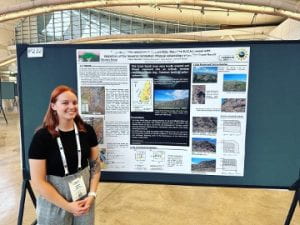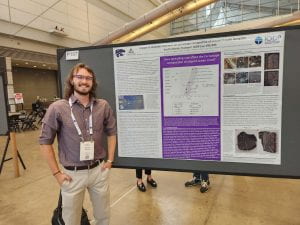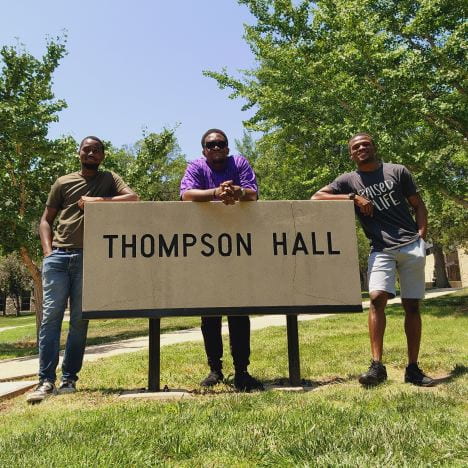After 68 years in Thompson Hall, we are gradually moving towards a new chapter and a new home for the geology department at Kansas State University.
Continue reading “A new chapter for geology – update on relocation plans”
After 68 years in Thompson Hall, we are gradually moving towards a new chapter and a new home for the geology department at Kansas State University.
Continue reading “A new chapter for geology – update on relocation plans”
 Huan pursued his doctorate at the University of Maryland using field and lab work to study the environmental context of early animal evolution. After obtaining his Ph.D. degree in 2015, he moved to Wisconsin (2016-2018), Brussels (2018-2020), and Paris (2020-2022) for postdoctoral research. Prior to K-State, he held an Assistant Professor position at Mississippi State University (2022-2024).
Huan pursued his doctorate at the University of Maryland using field and lab work to study the environmental context of early animal evolution. After obtaining his Ph.D. degree in 2015, he moved to Wisconsin (2016-2018), Brussels (2018-2020), and Paris (2020-2022) for postdoctoral research. Prior to K-State, he held an Assistant Professor position at Mississippi State University (2022-2024).This past summer, five of our students (Sami Villasana, Celine Mazzella, Zane Barrow, Ethan Senne and Matt Arana) attended our International Field Camp in France. They are sharing their experience with us:
Continue reading “Our Students Sharing their Field Camp Experiences”
As you may know, Dr. Karin Goldberg has moved to Colorado for news adventures. Here are some news from her:
“My move to Colorado has been bittersweet. On the sweet side, Fort Collins is a vibrant college town with charming, diverse restaurants and beautiful neighborhoods with neatly manicured lawns punctuated by parks. There are trails everywhere and the Front Range is right there! Every weekend we explore a new hiking trail, with such explicit geology that I feel like making Geonugget videos all the time! The views are magnificent and awe-inspiring, and I keep taking pictures of rocks, structures and features for my classes. Only to remember that teaching classes is probably something I will not be doing in the near future, which brings me to the bitter side of the move… I miss our students, sharing my excitement about the things I see with them and with my colleagues, and I miss our K-State community. I still have the pleasure of teaching Earth Through Time online, and I have also taken up three geology courses on a local community college, but this is likely to be temporary, as I have started my consulting business and have also applied for other full-time jobs. I am excited for what the future will bring and look back at my time with the Department of Geology at K-State with gratitude for the opportunities and enriching experiences, but most importantly with a heart full of love and longing for the good people I left there.”
Some of our undergrad students who are deeply involved in research projects have presented their results at the 2023 Geological Society of America meeting held in Pittsburgh this past October. Below are their feedbacks.
Celine Mazzella (Senior, B.Sc Geology)
 At this year’s annual GSA meeting I presented research of the Jackson Hole volcanics in Northwestern Wyoming, specially the Flat Creek Basalt area. The focus of this research was to constrain the lava flow to either being a local eruption or not, and if it occurred over one episode or multiple. The reason we looked at this area was because it is the first known instance of a basaltic eruption prior to the Yellowstone Plateau Volcanic System developing. After going out to the field site and confirming the presence of at least one dike we were able to determine that this lava was locally erupted and happened in a singular episode.
At this year’s annual GSA meeting I presented research of the Jackson Hole volcanics in Northwestern Wyoming, specially the Flat Creek Basalt area. The focus of this research was to constrain the lava flow to either being a local eruption or not, and if it occurred over one episode or multiple. The reason we looked at this area was because it is the first known instance of a basaltic eruption prior to the Yellowstone Plateau Volcanic System developing. After going out to the field site and confirming the presence of at least one dike we were able to determine that this lava was locally erupted and happened in a singular episode.
Quinton Mindrup (Senior, B.Sc Geology)
 I had two poster presentations at the 2023 National GSA conference. The first one was over the “Impact of seawater alteration on Cu isotope composition of oceanic basalts along the South Atlantic Transect: IODP Exp 390/393” which I presented on the first day. The second was over “Lithium concentrations in Cenozoic rhyolite vitrophyres and quartz-hosted melt inclusions: implications for lithium deposits in the northern Great Basin (U.S.A.)” on the second day. I had a great time presenting both of these posters and had so many great conversations. I really enjoy connecting with others over similar work we have done or fun ideas on what the data may mean.
I had two poster presentations at the 2023 National GSA conference. The first one was over the “Impact of seawater alteration on Cu isotope composition of oceanic basalts along the South Atlantic Transect: IODP Exp 390/393” which I presented on the first day. The second was over “Lithium concentrations in Cenozoic rhyolite vitrophyres and quartz-hosted melt inclusions: implications for lithium deposits in the northern Great Basin (U.S.A.)” on the second day. I had a great time presenting both of these posters and had so many great conversations. I really enjoy connecting with others over similar work we have done or fun ideas on what the data may mean.
 August 20, 1926 – August 26, 2023
August 20, 1926 – August 26, 2023
It is with deep sadness that we inform you about the passing of Robert “Bob” Douglas Cowdery, a petroleum geologist, and a tremendous supporter of the department of Geology.
Bob enrolled at Kansas State University in 1944, then in December of that year he enlisted in the army and after training was on his way to Taiwan when the A bomb was dropped on Japan. He then served in Honolulu as a Tech St. After his discharge in 1946 Bob returned to Kansas State and graduated in 3 years with a degree in Physical Science with a major in Geology in 1949. He was a member of Beta Theta Pi, Phi Kappa Phi (an honorary scholastic fraternity), and Sigma Delta Epsilon (an honorary geological fraternity). In 1991 Bob received the Kansas State University Distinguished Service Award. Bob completed many courses in anthropology and business attending the University of Denver, University of Colorado, Colorado School of Mines, Butler Co. Community College and Wichita State University.
After graduation Bob was employed by Cities Service Oil Company in Oklahoma City and Great Bend. Bob began working for Petroleum, Inc. in 1951 and continued for 38 years. He spent 22 years in the Denver area exploring for oil in the Rockies. In 1975 he moved to Wichita as the company exploration manager responsible for oil exploration in 11 states. In 1985 he served Petroleum, Inc. as president and chief operating officer and retired in 1988.
Bob was a member of the Rocky Mountain Association of Geologists, Kansas Geological Society, a charter member of American Institute of Geologists, Kansas Geological Foundation, Society of Independent Earth Scientists, and a senior member of the Geological Society of America. He served as president and headed many committees of these professional organizations. In 1996 he was elected president of the American Association of Petroleum Geologists.
Thank you for your service and your active support in Geology Bob! Rest in Peace!
We are proud to announce great achievement of three of our Graduate Students.
Tochukwu Onyebum, a graduate student from the Department was recently awarded two prestigious scholarships by the Society of Exploration Geophysicists (SEG), including the SEG Foundation/Chevron Scholarship and Geophysical Society of Tulsa/SEG Scholarship. These scholarships will significantly support his academic program and research at Kansas State University. Tochukwu’s research interests include seismicity (earthquakes) and mantle geodynamics. He’s working with Dr. Claudia Adam on research to investigate the relationship between mantle dy namics and surface deformation over central and eastern United States by modeling mantle convection from global and regional seismic tomography models. Tochukwu was previously awarded the SEG/Jack & Catherine Threet Scholarship and SEG Foundation Scholarship for the 2022/2023 academic session.
namics and surface deformation over central and eastern United States by modeling mantle convection from global and regional seismic tomography models. Tochukwu was previously awarded the SEG/Jack & Catherine Threet Scholarship and SEG Foundation Scholarship for the 2022/2023 academic session.
Jallow Muhammed is a graduate student working under Dr. Abdelmoneam Raef’s supervision. Jallow’s research focuses on providing a robust, effective, data-driven horizon-focused method that recognizes and corrects for tuning effects on seismic attributes utilizing statistical methods and machine learning. He was recently awarded the SEG Thomas A. Mazza Memorial Scholarship and the SEG Foundation/Chevron Scholarship. These scholarships are prestigious scholarships supporting aspiring geoscientists. They provide financial assistance to students pursuing geophysics and related fields while promoting diversity, inclusivity, academic excellence, and leadership potential, fostering the growth of future industry leaders, and honoring the legacy of Thomas A. Mazza.
Fidelis Onwuagba was awarded the SEG Foundation Scholarship for the 2023/2024 academic session. He is investigating Uranium in Groundwater and its Potential as a Natural Contaminant in the Cherokee Basin, Southeastern Kansas, with Associate Prof. Karin Goldberg. This is Fidelis’ second consecutive award from the Society of Exploration Geophysicists; he was also awarded the SEG Foundation/Chevron Scholarship for the 2022/2023 academic session.
Matthew Brueseke, professor in the geology department, has been named a fellow of the Geological Society of America, a global professional organization with more than 26,000 members in 115 countries.
 As explained by the society’s selection committee, “Society Fellowship is an honor bestowed on the best of our profession.” It recognizes an individual’s sustained contributions to geosciences through research, teaching, public outreach and leadership in the field. According to Brueseke’s primary nominator, Pamela Kempton, professor and department head in geology at K-State, “Matt is particularly recognized for the breadth of his accomplishments as an outstanding teacher and mentor; a leader in service to Geological Society of America and the profession; and a renowned researcher who integrates field and lab methods with quantitative analysis to address problems in igneous petrology, volcanology, geochemistry, petrogenesis and tectonics.”
As explained by the society’s selection committee, “Society Fellowship is an honor bestowed on the best of our profession.” It recognizes an individual’s sustained contributions to geosciences through research, teaching, public outreach and leadership in the field. According to Brueseke’s primary nominator, Pamela Kempton, professor and department head in geology at K-State, “Matt is particularly recognized for the breadth of his accomplishments as an outstanding teacher and mentor; a leader in service to Geological Society of America and the profession; and a renowned researcher who integrates field and lab methods with quantitative analysis to address problems in igneous petrology, volcanology, geochemistry, petrogenesis and tectonics.”
Brueseke has successfully built and maintained a student-centered, internationally recognized research program focused on igneous petrology, economic geology and tectonics, and he has been the principal investigator or co-principal investigator on proposals totaling more than $1.9 million dollars in external funding. Brueseke’s research is notable for combining field-based geologic mapping and petrologic/petrographic observations with geochemical, isotopic and geochronologic data. He and his students synthesize these diverse datasets into innovative tectonic models that are viewed by his colleagues as transformative and game-changing.
Brueseke has also been recognized for the excellence of his teaching, having been awarded both the Page Twiss Faculty Development Award for Excellence in Graduate Teaching and Advising and the Geology Department Faculty Development Award for Excellence in Undergraduate Teaching and Advising.
Brueseke earned his bachelor’s degree and doctorate from Miami University. He was nominated for the Geological Society of America fellowship by four colleagues: Jeffrey M. Trop, Bucknell University; Christopher D. Henry, Nevada Bureau of Mines and Geology, University of Nevada, Reno; Charles G. Oviatt, emeritus professor, and Pamela Kempton, both of the K-State geology department.
Well done Matt!
 Chlorite, this very common weird looking green mineral, is found almost everywhere. It is associated with magmatic, metamorphic, and diagenetic reactions that occur over a wide temperature range. Due to its specific chemistry, knowing the composition of this mineral allows geoscientists to estimate the temperature of its formation, making chlorite a perfect geothermometer. In addition, this mineral provides indirect evidence for the presence of water in the environment in which it forms. Well, guess what. Chlorite has been detected on Mars! So, knowing its composition can help us to understand geological processes that have occured on the red planet. The Rover Perseverance, which landed on Mars on February 2021, carries a Raman spectrometric system that allows analysis of the composition of rocks and minerals. However, interpretation of the generated dataset requires that specific mineral calibrations exist for comparison. Dr. Lacroix has been working on chlorite for more than a decade and owns a collection of chlorite samples from around the world that encompass a large range of compositions. His graduate student, Sarah Lamm, analyzed representative samples from this chlorite ‘library’, using the Geology Department’s Raman spectrometer and produced the very first Raman chlorite calibration. The results which have been recently published in Journal of Raman Spectrometry, will be very useful for planetary scientists working on Mars and other planets. Sarah is now Ph.D student at the University of Kansas and continues her path to Planetary Science.
Chlorite, this very common weird looking green mineral, is found almost everywhere. It is associated with magmatic, metamorphic, and diagenetic reactions that occur over a wide temperature range. Due to its specific chemistry, knowing the composition of this mineral allows geoscientists to estimate the temperature of its formation, making chlorite a perfect geothermometer. In addition, this mineral provides indirect evidence for the presence of water in the environment in which it forms. Well, guess what. Chlorite has been detected on Mars! So, knowing its composition can help us to understand geological processes that have occured on the red planet. The Rover Perseverance, which landed on Mars on February 2021, carries a Raman spectrometric system that allows analysis of the composition of rocks and minerals. However, interpretation of the generated dataset requires that specific mineral calibrations exist for comparison. Dr. Lacroix has been working on chlorite for more than a decade and owns a collection of chlorite samples from around the world that encompass a large range of compositions. His graduate student, Sarah Lamm, analyzed representative samples from this chlorite ‘library’, using the Geology Department’s Raman spectrometer and produced the very first Raman chlorite calibration. The results which have been recently published in Journal of Raman Spectrometry, will be very useful for planetary scientists working on Mars and other planets. Sarah is now Ph.D student at the University of Kansas and continues her path to Planetary Science.

 Although not really related, but in order to continue within the Planetary Science topic, the department of Geology is glad to announce that Dr. Kirk, former team member of the USS Enterprise NCC 1701, recently published a new open access textbook titled “Microbiology for Earth Scientists”. It is probably a big change for Dr. Kirk to come back on Earth. The book seeks to advance understanding of the important roles that microorganisms play in shaping the Earth, including impacts related to water quality and climate change.
Although not really related, but in order to continue within the Planetary Science topic, the department of Geology is glad to announce that Dr. Kirk, former team member of the USS Enterprise NCC 1701, recently published a new open access textbook titled “Microbiology for Earth Scientists”. It is probably a big change for Dr. Kirk to come back on Earth. The book seeks to advance understanding of the important roles that microorganisms play in shaping the Earth, including impacts related to water quality and climate change.
You can download the book here.